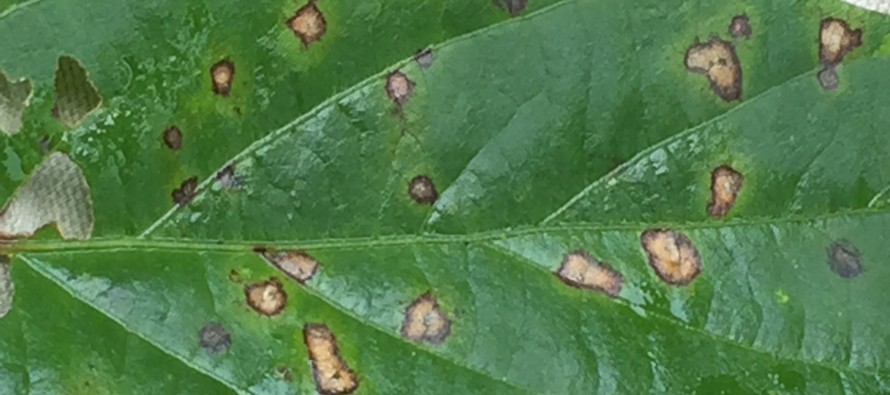Soybean R3/R4 Fungicide Selection

Related Articles
- 2010 Soybean And Corn Variety Trial Data 3
- Rice Variety Trial Results For 2010, Plus Rice Research Report 0
- Evaluation of Peanut Varieties in Mississippi, 2010 0
Latest Tweets
I have received numerous calls over the past two weeks regarding fungicide selection for the R3/R4 application timing. As in the past, the automatic fungicide application should be specifically targeted in “high-yield” environments. A high-yield situation would be defined as an early-planted, irrigated, continuous soybean field situation (a wheat/soybean double-crop does not count as continuous soybean). In the past, an automatic fungicide application between R3 and R4 has provided between 3 and 6 bu/A approximately 60% of the time.
When deciding on a fungicide product for an application between R3 and R4 take into account some of the topics outlined below.
Generic azoxystrobin
Several products are likely available through retailers that contain azoxystrobin. Keeping up with this list of products has been difficult. In addition, each retailer may have their own formulation or product name. All of the available products should have the same efficacy as Quadris. However, keep in mind that as an R3/R4 application on a frogeye leaf spot-susceptible variety they will not provide yield protection due to the widespread strobilurin-resistance within the fungal population. Make sure you know the disease package of a particular variety before making an application of a stand-alone strobilurin product. Either refer to the variety documentation for this particular information or refer to the 2015 MSU OVT disease ratings:
North MS (Verona, MS): https://www.mississippi-crops.com/2015/11/25/6916/
Maturity Group IV: https://www.mississippi-crops.com/2015/11/18/2015-soybean-ovt-foliar-disease-ratings-maturity-group-iv/
Maturity Group V: https://www.mississippi-crops.com/2015/11/20/2015-soybean-ovt-foliar-disease-ratings-maturity-group-v/
Put quite simply, if you have a frogeye leaf spot-susceptible variety in the field you either need to consider a tank mix fungicide combination of multiple modes of action, or a pre-mix fungicide product that contains a dual (or tri) mode of action. A stand-alone strobilurin will not be beneficial on a frogeye-susceptible variety, but would still be acceptable on a frogeye-resistant variety.
Quadris Top formulations
Keep in mind there may be multiple products under the brand name Quadris Top available through your local retailer. Quadris Top and Quadris Top SB are the SAME fungicide. Both products contain 18.2% azoxystrobin and 11.4% difenoconazole. The SB simply denotes “soybean”. However, do not confuse Quadris Top SB and Quadris Top SBX as they are slightly different. Quadris Top SBS is a new formulation of the two active ingredients and is a 1:1 ratio of the two actives (19.8% azoxystrobin and 19.8% difenoconazole). Be mindful that the application rate for Quadris Top (or SB) is 8-14 fl oz/A while the application rate for Quadris Top SBX is 7.0-7.5 fl oz/A. Both products have an 8 fl oz/A use rate. The pre-harvest interval (PHI) is the same for all three products.
Application timing
The environment that occurs post-application is important as to whether or not disease will occur. In the past few years I have heard plenty of people suggest that just because it is hot and dry at the time of application means they should delay the fungicide application. An application made at R3/R4 will help prevent things from occurring post-application. The environment at the time of application or prior to application is not the most important determining factor. Personally, I prefer fungicide applications at the automatic timing made closer to R4 or even R4.5 to provide the fungicide residual into R5 grain filling stages. Most fungicide applications made with the label rate will provide some residual activity for between 17 and 21 days depending on the products applied.
Rates
I cannot stress enough how important rate choice is in managing disease as well as providing a lengthy residual. In the past, the majority of the R3/R4 fungicide applications contained a reduced rate of a stand-alone strobilurin (4 versus 6 fl oz/A of either Headline or Quadris). Rates were reduced as there was not perceived to be a difference in the yield benefit between a 4 or 6 fl oz/A application. I would not suggest that reducing the rate had anything to do with the development of widespread resistance since some locations where resistance was identified had not ever received a strobilurin fungicide application. However, with all that said, the 2 additional fl oz/A in a 6 fl oz/A application could provide as much as 7 days of added residual on the tail end. Depending on what the environment decides to do this season that may mean the difference between a carefully timed single fungicide application and the need for a second fungicide application depending on disease incidence and severity for the remainder of the season. But, with that said I am not suggesting that two fungicide applications are better than one nor are two applications generally necessary.
Application volume
Increasing application volume can increase plant coverage. In the majority of the trials conducted in my program over the years, fungicides have either been applied in 10 or 15 gpa. Aerial application volumes differ greatly and in most cases fungicides are being applied in 3 gpa. I would prefer applications be made in 5 gpa by air, but I realize that may cost a little bit more and if ag pilots are behind in making applications they will choose a reduced volume to increase the number of acres flown in a single load. Applications made by ground should not be made in less than 10 gpa and can depend on whether or not disease has been observed in the crop.




Let me tell You a sad story ! There are no comments yet, but You can be first one to comment this article.
Write a comment